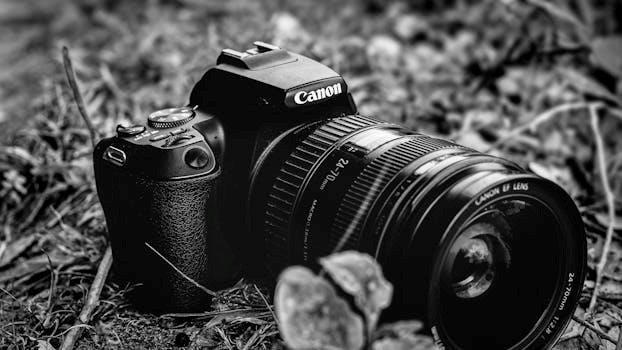
canon manual fl lens user manual
The Canon FL lens mount represents a significant era in Canon’s history, serving as their second SLR system from 1964 to 1971; This mount replaced the older Canon R lens mount, offering a new design for photographers․ These lenses are designed for use on the Canon FP, FX, TL-QL, and FT-QL cameras, which require manual operation of the aperture control․
Overview of the Canon FL Mount System
The Canon FL mount system, introduced in 1964, marked a transition from the earlier R mount, showcasing Canon’s commitment to innovation in SLR technology․ This system was designed for a range of cameras, like the FP, FX, TL-QL, and FT-QL, all of which required manual control of the lens diaphragm․ Unlike modern autofocus systems, the FL mount relied on direct manual adjustments for aperture and focus, offering photographers a hands-on experience․ The mount’s design facilitated the use of interchangeable lenses, encouraging photographers to explore various focal lengths and perspectives․ A key feature of the FL system was the use of preset and automatic diaphragms, which allowed for precise control over depth of field and exposure․ These lenses are known for their robust construction and optical quality, contributing to the popularity of vintage photography enthusiasts․ The FL mount’s legacy lives on, with many users still appreciating the manual control and the unique image characteristics offered by these lenses․ The system’s simplicity and mechanical reliability have made it a favorite among those who enjoy the tactile nature of film photography․
Historical Context of FL Lenses
The Canon FL lenses emerged during a pivotal period in photographic history, spanning from 1964 to 1971․ This era witnessed the rise of single-lens reflex (SLR) cameras and a growing demand for interchangeable lenses․ The FL mount system was Canon’s second venture into SLR lens mounts, succeeding the R mount․ This transition reflected Canon’s commitment to enhancing the user experience and improving optical performance․ The FL lenses were designed for manual operation, aligning with the prevailing photographic practices of the time․ They were crafted to pair with camera bodies like the FP, FX, TL-QL, and FT-QL, each offering unique features to complement the lenses․ These lenses were at the forefront of technology, offering both preset and automatic diaphragm operation, which allowed photographers more control over their images․ The robust construction and high-quality optics of these lenses made them a popular choice for both amateur and professional photographers․ The FL system played a crucial role in establishing Canon as a major player in the camera industry, setting the stage for future innovations․ The legacy of these lenses continues to be celebrated by vintage photography enthusiasts today․
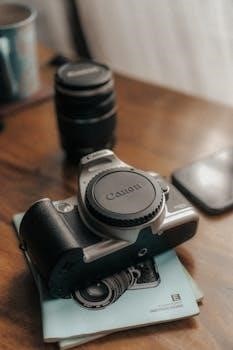
Canon FL Lens Compatibility and Usage
Canon FL lenses are specifically designed for use with Canon cameras such as the FP, FX, TL-QL, and FT-QL models․ These lenses feature manual diaphragms, requiring manual adjustment of the aperture control ring․
Cameras Compatible with Canon FL Lenses
The Canon FL lens mount was primarily designed for a specific range of Canon SLR cameras produced during the mid to late 1960s and early 1970s․ These cameras form the foundation of the FL system and are essential for those looking to utilize these classic lenses․ The most notable cameras compatible with Canon FL lenses include the Canon FP, which was an early model in the FL line, the Canon FX, a model that offered improvements over the FP, and the Canon TL-QL, with its quick loading mechanism․ Also compatible is the Canon FT-QL, which was another camera in the line known for its quality and robust build․ These cameras feature the necessary mount and metering systems to properly interface with FL lenses․ It is critical to note that FL lenses are not compatible with Canon’s later FD mount cameras․ Understanding camera compatibility is crucial before purchasing or attempting to use FL lenses to avoid damage or improper function․
Manual Operation of FL Lens Diaphragms
Canon FL lenses are characterized by their manual diaphragm operation, requiring photographers to set the aperture directly on the lens itself․ This differs significantly from modern lenses with automatic aperture control; The aperture ring, typically located on the lens barrel, is used to manually adjust the lens diaphragm, controlling the amount of light that passes through to the camera’s sensor or film․ This manual operation demands a more active role from the photographer, who must carefully consider and set the appropriate aperture for the desired depth of field and exposure․ The lenses might feature a preset diaphragm, where you can select an aperture and then quickly open the lens for focusing, then return to the set aperture for the shot․ Understanding this manual process is key to effectively using FL lenses, and proper adjustment contributes to correct exposure for each image․ Mastering the manual control over the aperture is crucial when working with vintage FL lenses․
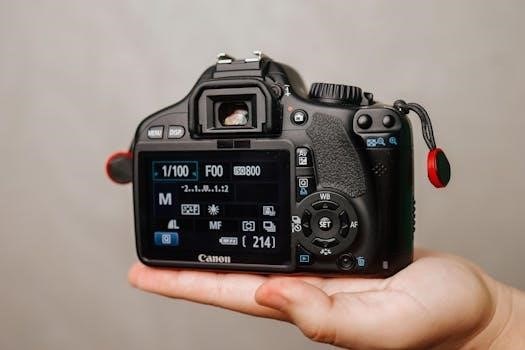
Understanding Canon FL Lens Features
Canon FL lenses showcase distinct characteristics, including preset and automatic diaphragm options․ Wide-angle FL lenses can exaggerate distance, producing varied and interesting effects․ Understanding these aspects enhances the user experience with these vintage lenses․
Preset and Automatic Diaphragm Operation
Canon FL lenses feature both preset and automatic diaphragm operation, offering photographers flexibility in controlling aperture settings․ The preset diaphragm allows the user to manually select an aperture, with a dedicated ring used to “stop down” to the chosen f-number just before taking the picture․ This method provides precise control for creative effects and depth-of-field management․ Conversely, automatic diaphragms, which were a later addition to the FL system, offer a convenient way to maintain a wide-open aperture for focusing and composing, before automatically stopping down to the preset aperture at the moment of exposure․ Understanding the nuances of both systems is crucial when working with FL lenses․ The user can manipulate the manual aperture ring to set the desired aperture․ The photographer should return the manual aperture ring to the open position after checking the lens aperture․ This dual approach caters to a range of shooting styles and needs, making the FL lens system versatile for its time, and providing a unique experience for today’s vintage lens enthusiasts․ This system allows for both creative and functional shooting․
Characteristics of Wide Angle FL Lenses
Wide-angle FL lenses possess distinct characteristics that differentiate them from standard or telephoto lenses within the Canon FL system․ These lenses are known for their ability to capture a broader field of view, making them ideal for landscape photography, architectural shots, and situations where a wide perspective is desired․ A notable characteristic of wide-angle lenses is their tendency to exaggerate the sense of distance․ This can be used creatively to produce varied and interesting compositions, as objects in the foreground will appear closer while background elements recede further․ The user should be aware of this effect, and use it to their advantage when framing a shot․ However, this distortion can also present a challenge for those unfamiliar with wide-angle optics, requiring careful attention to perspective and composition․ Additionally, these lenses often exhibit a greater depth of field, meaning more of the scene will be in focus at a given aperture setting․ The wide angle lenses can be a great tool when used properly․ This contributes to their versatility in various shooting conditions․
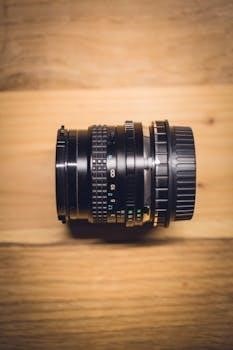
Resources for Canon FL Lens Users
Finding support and information for Canon FL lenses can be achieved through online forums and communities․ User manuals are often available, sometimes requiring a small payment to cover hosting and shipping costs․ Canon USA provides support for its products․
Availability of Canon FL Lens Manuals
Locating original Canon FL lens manuals can sometimes be a challenge, given their age, but it’s not impossible․ Many enthusiasts and collectors have scanned and made available digital versions online․ However, physical copies are still sought after by collectors․ These manuals are crucial for understanding the nuances of the lens, from its construction to its proper usage, especially concerning diaphragm operation․ Some online resources offer manuals, often requiring a small fee to support their websites and cover shipping costs if physical copies are involved․ These manuals can be found on dedicated camera forums, online marketplaces, or through independent sellers specializing in vintage camera equipment․ It is essential to check the manual’s condition before acquiring it, as some may have wear and tear․ Some owners might add tape for preservation․ There are also instructionals available․ They are usually in english and small and light․ By using these resources you can learn a lot about your lens․
Finding Support and Information
For those seeking support and additional information regarding Canon FL lenses, there are various avenues to explore․ The primary resource would be the user manuals, which can often be found online, either as free downloads or for a small fee, supporting the websites that host them․ Canon USA, Inc․ provides support for a wide array of their products, including access to their user manual library․ However, specific support for older lens systems may be limited․ Online forums and communities dedicated to vintage photography are treasure troves of collective knowledge․ Here, experienced users share their insights, tips, and troubleshooting advice․ Additionally, independent camera shops that specialize in vintage equipment can offer expert advice and services․ Online marketplaces, often used for buying and selling, can also connect you with knowledgeable individuals․ These communities are invaluable for solving specific issues, learning advanced techniques, and connecting with other FL lens enthusiasts, thus enriching your experience․
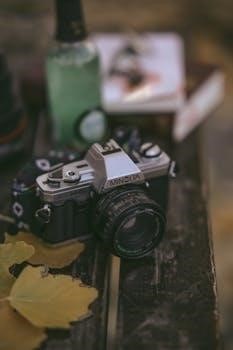
Practical Aspects of Using Canon FL Lenses
When using Canon FL cameras, ensure the correct film loading, which is typically a standard 35mm film roll using a quick loading mechanism․ Considering these lenses are vintage, be aware of their condition and age․
Film Loading with Canon FL Cameras
Canon FL cameras, known for their robust design and manual operation, utilize a straightforward film loading process, typically accommodating any standard 35mm film roll in a cartridge․ The quick-loading, or QL, mechanism is a key feature, simplifying the film insertion procedure․ To load film, begin by opening the camera back, usually by pulling up the rewind knob․ Then, insert the film cartridge into the designated chamber․ Next, extend the film leader across the camera body and into the take-up spool․ Ensure the film engages with the spool’s teeth․ Close the camera back securely․ Advance the film lever a couple of times until the frame counter displays ‘1’․ This ensures the film is properly advanced and ready for shooting․ This is designed to make the process more user-friendly compared to older film cameras․ The QL mechanism reduces the chances of improper loading and film damage․ Always double-check that the film is correctly aligned before closing the back of the camera․ With a little practice, loading film into your Canon FL camera will become second nature․
Vintage Item Considerations for FL Lenses
When acquiring Canon FL lenses as vintage items, several factors warrant consideration․ Given their age, these lenses may exhibit signs of wear and tear․ Check for scratches on the glass elements, which can affect image quality․ Inspect the aperture ring and focus mechanism for smooth operation; stiffness or looseness can indicate issues․ Look for any fungus or haze inside the lens, which can severely impact performance․ Additionally, the lens mount should be free of damage to ensure proper attachment to your camera․ Many of these lenses have been used for many years, so some wear is expected․ Moreover, evaluate the overall condition of the lens barrel for dents or damage․ Remember, these lenses are from a time when manufacturing tolerances were different, so some minor imperfections are normal, but any significant flaws should be taken into account․ Finally, consider that the lens may require cleaning or servicing by a professional to restore its optimal functionality․ Assessing these points helps determine its suitability for use․
Related Posts

king 5500 pellet stove manual
Download the King 5500 pellet stove manual for easy installation, troubleshooting, and maintenance tips. Your ultimate guide to efficient heating!

proform 505 cst treadmill manual
Download the comprehensive ProForm 505 CST Treadmill Manual for free. Your ultimate guide to setup, maintenance, and troubleshooting.

graco nautilus 65 owners manual
Get the Graco Nautilus 65 owner’s manual for easy access to safety features, installation tips, and troubleshooting. Download your guide now!